Just about 900 m from my home in Panama city passes by the Matías Hernández river, with so much sadness I must be honest and annotate that the river is highly contaminated with human waste. This part of the river is close to the shore so all type of debris accumulate here but also lots of shore or wading birds arrive to feed on fish and crustaceans, take a bath on freshwater, sleep on trees or simply hang around, but other type of birds can also be seen there.
Especially during winter migration, flocks of certain migrants can be seen. From time to time I visit this area and a lot of my pictures have been made there. This is a selection of these pictures, please take ino account that several of these pictures were done with Pentax Tele-Takumar manual lenses (lenses from the 60's) which I used when I was starting wildlife photography early this year and hence image quality is not as good:
Black-crowned Night-Heron (Nycticorax nycticorax). Fairly common in freshwater marshes and swamps in lowlands and
along coasts. More common on Pacific slope than on Caribbean.
Black-necked Stilts (Himantopus mexicanus) are fairly
common along both coasts, more on Pacific. Found on mudflats and shallow
water habitats. Occurs all year but more from September to March due to
migrants like this flock.
Brown Pelican (Pelecanus occidentalis) is very common on both coasts, breeding on islands in the Pacific. This young dude was walking in a residential area in Costa del Este near the river, I had the camera with me so immediately took advantage to take the picture.
Cocoi Heron (Ardea cocoi) is uncommon on Pacific
slope from eastern Panamá Province eastward, with vagrants as far west
as Herrera. Its natural habitats are rivers, swamps, and freshwater lakes.
Greater Ani (Crotophaga major) is common on Caribbean
slope from western Colón and Pacific Canal Area eastward. Found in
groups in lowlands, in dense vegetation bordering rivers and streams and
in swamps and marshes.
The Mangrove Cuckoo (Coccyzus minor) is rare in lowlands near Pacific coasts, not restricted to mangroves. Its status is uncertain with most reports in winter, suggesting that these records pertain to migrants from the north, but may breed in Panama.
The Little Blue Heron (Egretta cerulean) is a common migrant with some present all year. Their plumage is white when immature molting to purplish blue when mature, rarely breeds in Panama.
Merlin (Falco columbarius) is a rare transient and winter resident mainly along coasts, also inland in open areas. I was fortunate enough to watch not one but two individuals hunting betwen Corotú (Enterolobium cyclocarpum) trees.
Neotropic Cormorant - adult
Neotropic Cormorant - immature
Neotropic Cormorant (Phalacrocorax brasilianus) is common on both coasts and lakes and rivers; occasionally on smaller streams. Breeds in colonies on offshore islands, mangroves and Lago
Bayano. Adults are mostly black and immature brownish, paler below.
Spotted Sandpiper (Actitis macularius) is a very
common transient and winter resident. Occurs anywhere near water, from coastal areas to small mountain streams. Immatures do not have the spots on breast that make the species distinctive.
The Turkey Vulture (Cathartes aura) is very common nearly throughout the country. Resident population is supplemented by thousands of migrants during winter. It ranges from southern Canada to the southernmost
tip of South America. It inhabits a variety of open and semi-open areas,
including subtropical forests, shrublands, pastures, and deserts.
The Whimbrel (Numenius phaeopus) is a very common
winter resident. Found on both coasts, more in the Pacific. It breeds
across much of subarctic North America, Europe and Asia as far south as
Scotland. On the background you can watch another Whimbrel, a sandpiper and a Southern Lapwing.
The White Ibis (Eudocimus albus) are fairly common
along the Pacific coast on mudflats, mangroves and adjacent wetlands,
very rare on Caribbean coast in Bocas del Toro and Canal Area. Breeds in
colonies around Gulf of Panama and on islands.
Wood Stork (Mycteria americana) is uncommon on Pacific
slope, rare on Caribbean slope in Bocas del Toro and Canal Area. Occurs
in lowlands in marshes and swamps.
Yellow-crowned Night Heron (Nyctanassa violacea) is
common on the Pacific coast but uncommon on the Caribbean coast, and
inland on rivers and marshes in lowlands, rare in highlands. It's mainly
nocturnal but along coasts often seen by day.
Other species I have watched in the river and its surroundings include: Osprey, Zone-tailed Hawk, Tricolored Heron, Snowy and Great Egrets, Wattled Jacana, Yellow (Mangrove) Warbler, Plain Wren, Barred Antshrike, Orange-crowned Oriole, Crested and Yellow-Headed Caracaras, Black-bellied Whistling Duck, Muscovy Duck, Belted, Ringed and Amazon Kingfishers, Southern Lapwings, Northern Waterthrush, Swainson's Thrush and of course other super common species to the city.
Soon I expect to post more from this great place to do wildlife photography.




.jpg)








.jpg)


.jpg)


Best Patriotic Pitbull T-Shirt 4th July USA American Flag Shirt : http://bit.ly/2W87rX0
ReplyDeleteBest Patriotic Pitbull T-Shirt 4th July USA American Flag Shirt : http://bit.ly/2W87rX0
Best Patriotic Pitbull T-Shirt 4th July USA American Flag Shirt : http://bit.ly/2W87rX0
Best Patriotic Pitbull T-Shirt 4th July USA American Flag Shirt : http://bit.ly/2W87rX0
Best Patriotic Pitbull T-Shirt 4th July USA American Flag Shirt : http://bit.ly/2W87rX0
Best Patriotic Pitbull T-Shirt 4th July USA American Flag Shirt : http://bit.ly/2W87rX0
Best Patriotic Pitbull T-Shirt 4th July USA American Flag Shirt : http://bit.ly/2W87rX0